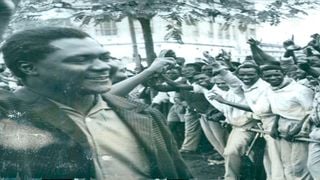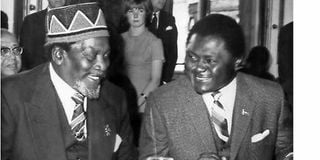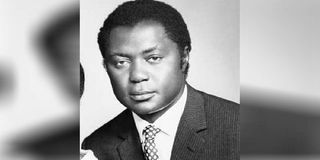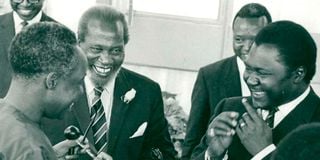
Tom Mboya is greeted by jubilant crowds flashing the Kanu one finger salut after the elections in 1963. Mboya was described in the Western world as personable and articulate. He even appeared on the ‘Time’ magazine cover in 1960.
Weekly Review
Premium
Kenya’s President who never was: CIA files reveal fresh details about Tom Mboya
The US Central Intelligence Agency loved Tom Mboya. It kept tabs on him and a close look at his politics.
Three months before the 54th anniversary of his death, the CIA released one more file on Mboya.
That CIA files on Mboya are still being released with redacted passages is an indicator of the sensitive nature of the man who was billed as the president who never was.
Apart from the positive adjectives used on Mboya, we know little about the details of the CIA’s thinking about Kenyatta succession and the place of Mboya.
Two years before Mboya was gunned down on a Saturday afternoon, July 5, 1969, the CIA had filed reports of “younger Kikuyus” attempts to “neutralise him” over the Kenyatta succession. It also admitted that his closeness to the US was being used “as a weapon against him” and that he had acquired many enemies.

Mzee Jomo Kenyatta and Tom Mboya share a joke at the 1962 independence conference in London.
Whether Mboya knew of these attempts is unclear and does not explain why such a vulnerable personality was walking with no bodyguards on a city street on the day he was killed.
That day, his white Mercedes Benz registration KME 627 was parked outside Channi’s Pharmacy. Mr and Mrs Channi were Mboya’s family friends. Though they were about to close for the weekend, the minister had called asking them to wait for him to purchase some drugs.
How did the assassins know Mboya would be at the chemist?
“In December 1967, he was involved in a shooting incident which was rumoured to have been an attempt to assassinate him,” the CIA said.
Historians regard the CIA files on African personalities as part of the records on the US meddling in the continent’s politics in the 1960s. It was a decade the CIA was known to prop up leaders, engage in assassinations and stage coups as it did in Congo.
The CIA appears to have known that Mboya was suspected of being a CIA project. The file says he was being derided as “the American ambassador to Kenya” and attributes that to “jealousy”.
Whether Mboya was aware of threats to his life was unknown – and it will never be known why he was walking alone on the day he was gunned down.

Tom Mboya, the Economic Planning Minister, signs the book of condolences for the family of Senator Robert Kennedy at the US Embassy in Nairobi.
One question never answered was what Mboya was up to. A CIA report made before his death says Mboya “had surrounded himself with bright, moderate politicians and civil servants who look to him for leadership and guidance”.
Whether this was considered part of his preparation for leadership is unclear. But, the CIA reported that he had realised he required a tribal base and seemed to have shifted his attention to a future. Age was on his side.
“He realises that having deliberately established his reputation as a non-tribal politician from a Nairobi constituency whose main interest was the problems of the urban worker, he lacks any solid tribal political base. His recent efforts have been aimed at trying to build a new image of himself as a leader of the Luo and as one who is interested in the fate of the peasantry,” the report says.
Ever since he appeared on the March 7, 1960 cover of Time magazine cover, the then 29-year-old Mboya’s image was elevated to continental status. He was being touted as part of the new generation of African leaders.
Seven years after the Time coverage, the CIA reported that Mboya was “for a long time … better known abroad than any other Kenyan politician”. That could have sparked the “jealousy.
A critical reading of the CIA records would mean that Kenyatta was not privy to Mboya’s death.
“Kenyatta is aware of the skills and talents the minister brings to the government, and he is no averse to having Mboya do work in Parliament and elsewhere where intelligence and political skills are required,” the CIA said.
“Mboya is by far the most able and most intelligent man in the Cabinet.”
For many, Mboya was the president Kenya missed. He had surprised many in Western circles with articulating complex political issues and the confidence exhibited in the speaking engagements he was invited to.

Tom Mboya.
So confident was Mboya that the 1960 Time magazine article reported that Mboya “who used to be courted only by English leftwingers, now holds forth suavely as honour guest in the private dining rooms of London’s largest banks and casually keeps a colonial governor waiting while he takes a shower”.
Apart from the “Kikuyu Establishment”, Mboya, according to the CIA, was opposed “by many members of his tribe, the Luo, who support former Vice-President Oginga Odinga.”
He was described as personable and articulate – and “his answers in any interview are so well organised that they can be printed as spoken without any change”.
In one of the dossiers made public in March this year, Mboya is described as “articulate, brilliantly logical and a masterful tactician” whose only liability is “being too young (he was 37 then), too westernised and too detribalised”.
“It is a reflection of Mboya’s competence and resilience that he has been able to survive the jealousies and rivalries of Kenya politics and remain an important political factor in the country.”
Another CIA note on Mboya referred to him as the “symbol of African nationalism to the West”, and “clever and shrewd”.
So important was Mboya that three days after he was killed, a briefing on what the death meant marked “Top Secret” dated July 8, 1969, was placed before President Richard Nixon. It is marked “For Presidents Only”.
“Mboya had many enemies and several groups had a capability to pull off the assassination… the most likely suspects are a group of advisers around President Kenyatta called the ‘Kikuyu Establishment’. They felt increasingly threatened by Mboya’s growing stature and popularity.”
“Even if Kikuyu leaders did not kill Mboya, they are the main beneficiaries of the situation. Mboya’s death should assure the aging Kenyatta is succeeded by Vice-President Daniel arap Moi, who though not a Kikuyu is regarded as compliant to the tribe’s wishes.”

President Jomo Kenyatta, Tanzania President Julius Nyerere and Tom Mboya engage in a light banter at the Nairobi Airport on March 30, 1968. Tom Mboya was assassinated on July 5, 1969.
Nixon was told that Mboya was “one of the few government figures with nationwide appeal and had been expected to exert a moderating influence during the inevitable contest for succession when the unifying presence of 76-year-old Kenyatta is gone”.
The CIA dismissed the chances of the “pro-communist Oginga Odinga” from taking advantage of Mboya’s death since defections had weakened his Kenya People’s Union party.
In a July 23, 1969 briefing, the CIA said Nahashon Njenga, the man charged with Mboya’s murder, was also arrested over the 1965 killing of Oginga Odinga’s principal adviser but never tried.
Though it does not name the Odinga adviser, the only 1965 death was the assassination of Pio Gama Pinto.
“The government may attempt to counteract any charges that it is involved in the assassination of Mboya by implicating the Communists,” said the CIA report.
“The polarisation of politics along tribal lines will not necessarily lead to violence. Most politicians inside Kanu and out, although condemning blatant Kikuyu tribalism, are privately attempting to work out a political arrangement with Kenyatta. Kenyatta also provides a symbol of leadership to most Kenyans. Kenya may not survive his death without major disruption”.
Finally, the Moi group, not the “Kikuyu Establishment” would take advantage of Mboya’s death. Odinga would end up in detention and the 1969 elections reorganised the post-Mboya politics.





